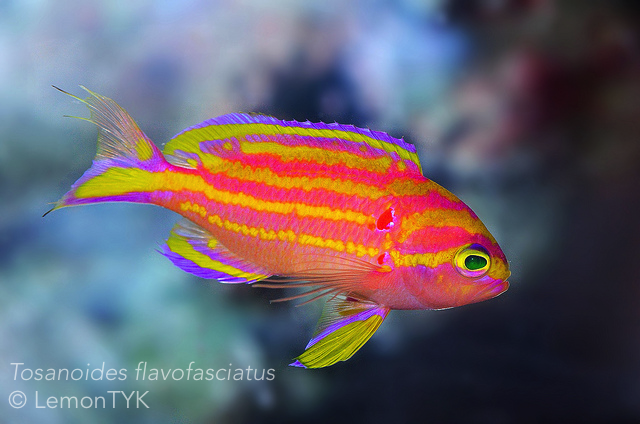A throwback to our final Osaka review saw us mentioning briefly the incredible prismatic beauty of Tosanoides flavofasciatus. Like Liopropoma aurora, this species, especially this particular specimen is deserving of a full and separate post to really showcase its beauty and story. T. flavofasciatus is joined by only one other member in this genus and is found primarily in Japan, although its range extends to Palau as well.

T. flavofasciatus is the commoner of the two species, the other being T. filamentosus. While it cannot be considered rare, it is by no means a frequent sight. The species in itself is not rare in the wild, and like most Anthiines, are found living in harems with numerous females and a single male. In the aquarium trade, both species of Tosanoides are collected from Japan, where they stay for sale in the domestic market. Very few have ever been exported due to their high cost and scarcity.
T. flavofasciatus often shows up in higher end fish stores like BlueHarbor, Vessel and Lagoon. However the species is very often represented by females or juveniles, and males remain a rare commodity. Large stunning males like this are a whole different ball game, and are exceedingly uncommon. This individual here is one of the nicest, largest and most spectacular representation of this species i’ve ever seen. Since even transparent looking females and juveniles are very pricey, it’s not surprising that this species remains shelved within the stores locally for the domestic market.

Tosanoides is an unusual genus, and morphologically distinct from many other Anthiines. They’re rather high profiled, stocky, and have large rounded ventral fins. In both species, their fins and especially the tail are decorated with filamentous thread fin extension. T. filamentosus has dramatically longer fin accessories, and for that it is deserving of its name.
Both species are deepwater and are normally found below 200ft. In cooler months, and especially winter, they swim up to shallower waters where temperatures are still cool enough at depths of 110-160ft. Like all members of their subfamily, both species of Tosanoides are sexually dichromatic, and to a certain extent dimorphic as well. Females of both species are plain and unmarked, with shorter fin lengths and often without any threaded filaments. Females of T. flavofasciatus have colors only on their fins and face.

The males are simply stunning. In T. flavofasciatus, males are yellow striped, which is a literal translation from their specific epithet “flavofasciatus“. The tails is unique in having an oblique separation, with colors only on the lower lobe. The top portion remains clear. This species is extremely fascinating in its coloration, and it reminds me very greatly of certain tropical butterflies to sport structural coloration due to refractive scales.
In images captured by flash photography, T. flavofasciatus appears pinkish or purple in-between the yellow. This coloration although highly appealing, is not true to life. The “pink-stripe” has a refractive quality that can only be appreciated in person or in video. The pink stripes have a slaty, almost steely sheen to it that diffract light and appear differently at various angles. In person they are lilac, almost blue even. At certain oblique angles the fish appears pink. However when a camera flash is fired, the light flattens this characteristic and the steely qualities appear flat and pink.
This video above of a male specimen in the wild shows very clearly this phenomenon. Pay special attention to the coloration, and notice how it’s more lilac-blue than pink. A quick google image search for this species shows otherwise, with most photos represented by pink. White balance correction aside, the coloration is difficult to replicate due to this effect. While most photos show T. flavofasciatus in pink, the opposite occurs for videos and most appear true to life as lilac-blue.
Also notice the large group of females near the 40 second mark. They are comparatively drab against the stunning male. The large stunning individual in this post was hand carried back to Singapore from Osaka, and now lives very happily with a friend. You can expect updates on this fish in the future.

To end this post off, here’s a quick look at T. filamentosus. This stunning specimen from Lagoon shows a beautiful male in prime coloration. Notice the long trailing filaments that give this species its name. We won’t elaborate too much on this species, so as not to steal the Awesome Fish Spotlight on T. flavofasciatus. We’ll keep T. filamentosus for another day!



